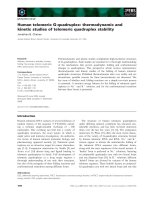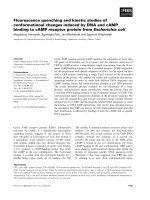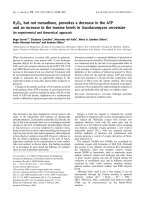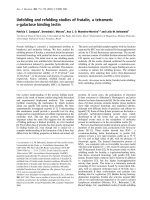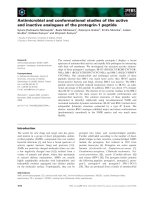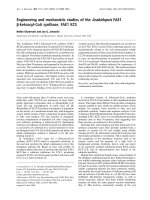Experimental and theoretical studies of waste heat driven pressurized adsorption chillers
Bạn đang xem bản rút gọn của tài liệu. Xem và tải ngay bản đầy đủ của tài liệu tại đây (3.49 MB, 221 trang )
EXPERIMENTAL AND THEORETICAL STUDIES OF
WASTE HEAT DRIVEN PRESSURIZED ADSORPTION
CHILLERS
LOH WAI SOONG
(B.Eng, Nanyang Technological University, Singapore,
M.Sc. National University of Singapore, Singapore)
A THESIS SUBMITTED
FOR THE DEGREE OF DOCTOR OF PHILOSOPHY
DEPARTMENT OF MECHANICAL ENGINEERING
NATIONAL UNIVERITY OF SINGAPORE
2010
Acknowledgements
i
Acknowledgements
I would like to extend my sincere and heartfelt thanks to my supervisors, Professor
Ng Kim Choon from the Department of Mechanical Engineering, for his invaluable
advice, guidance and constant encouragement throughout my whole candidature
study.
I also extend my sincere appreciation to Professor Bidyut Baran Saha of
Kyushu University, Japan, Assistant Professor Anutosh Chakraborty of Nanyang
Technological University, Singapore, for the encouragement and helpful technical
advice.
My thanks are also extended to Dr Yanagi Hideharu, (senior research fellow,
NUS), Mr. Sacadevan Radhavan, Mrs. Ang (from the Air Conditioning Laboratory),
and Mr. Tan (from the Energy Conversion Laboratory) for their kind support in this
research project. I am deeply grateful to my colleagues Dr. M Kumja, Dr. Kyaw Thu,
Dr. Mark Aaron Chan, Dr. He Jing Ming, Mr. Jayaprakash Saththasivam, Mr. Aung
Myat and Mr. Kazi Afzalur Rahman for their insightful suggestions, which have been
greatly helpful for the advance of my research.
Last but not least, I would like to take this opportunity to thanks my parents
for their unfailingly love, unconditional sacrifice and moral support, which are far
more than I could express in words. It is the encouragement from my family that
leads me to the end of this journey. I owe every bit of my happiness, satisfaction and
achievement to my family.
Loh Wai Soong,
(31 October 2010)
Table of contents
ii
Table of Contents
Acknowledgements i
Table of Contents ii
Summary vi
List of Tables viii
List of Figures ix
Nomenclature xvi
Chapter 1 Introduction 1
1.1 Background 1
1.2 Objectives 4
1.3 Scope 4
1.4 Organization 5
Chapter 2 Literature Review 9
2.1 Introduction 9
2.2 Adsorption mechanism 9
2.2.1 Adsorption equilibrium 10
2.2.2 Adsorption kinetics 14
2.2.3 Heat of adsorption 17
2.3 Characterization of carbon-based adsorbent 19
2.4 Thermally driven solid sorption systems 23
2.4.1 Adsorbent-adsorbate pairs for adsorption cooling systems 25
Table of Contents
iii
2.5 Summary 29
Chapter 3 Theory 30
3.1 Introduction 30
3.2 Adsorption characteristic 32
3.2.1 Isotherm 32
3.2.1.1 Surface Adsorption 33
3.2.1.2 Micropore Adsorption 35
3.2.2 Kinetics 38
3.2.2.1 Isothermal adsorption kinetics 39
3.2.2.2 Non-isothermal adsorption kinetics 39
3.2.3 Isosteric heat of adsorption 44
3.3 Thermodynamic property of adsorbent-adsorbate system 50
3.3.1 Specific heat capacity 52
3.3.2 Entropy 56
3.3.3 Enthalpy 58
3.3.4 Internal energy 59
3.4 Modelling of a pressurized adsorption refrigeration system 59
3.4.1 Mathematical modelling 61
3.5 Summary 69
Chapter 4 Experiments 71
4.1 Introduction 71
4.2 Uncertainty Analysis 72
4.3 Adsorption isotherm 73
4.3.1 Materials 74
4.3.2 Apparatus and procedure 75
Table of Contents
iv
4.3.3 Data Reduction 81
4.4 Adsorption kinetics 83
4.4.1 Material 84
4.4.2 Apparatus and procedure 84
4.4.3 Impact on Gaseous Compressibility 89
4.5 Batch-operated pressurized adsorption chillers 89
4.5.1 Design development and apparatus 89
4.5.2 Procedure 99
4.6 Summary 107
Chapter 5 Results and Discussion 108
5.1 Introduction 108
5.2 Adsorption isotherms 108
5.3 Isosteric heat of adsorption 122
5.4 Adsorption kinetics 125
5.4.1 Effects of heat evolution during adsorption process 126
5.4.2 Effects of compressibility of adsorbate during charging 130
5.4.3 Validation of proposed model with experimental kinetics data 132
5.5 Thermodynamics properties 143
5.6 Thermodynamic modelling of pressurized adsorption refrigeration system 145
5.7 Pressurized adsorption refrigeration system 152
5.8 Summary 162
Chapter 6 Conclusions 163
6.1 Conclusions 163
6.2 Recommendations for Future Work 166
Table of Contents
v
References 167
Appendices 185
Appendix A Basic wiring for ER3000 to PC 185
Appendix B Design calculations of adsorber/desorber beds for the pressurized
adsorption chiller using Maxsorb III and R134a 187
Appendix C Adsorption kinetics experimental data for Maxsorb III with R410a,
R507a, and methane (CH4) 189
Appendix D Programming Flow Chart of the PAC 195
Appendix E Specifications of component and material properties used in the
simulation code 196
Appendix F List of Publications 197
Summary
vi
Summary
The present study on adsorption refrigeration is motivated by two main factors.
Firstly, there is a global thrust towards the minimal usage of primary energy source
from fossil fuels and secondly the ecological problem concerning the emission of
chlorofluorocarbons (CFCs) from refrigerating units. These trends bring to a strong
exigency of adsorption refrigeration systems. In this context, the research work
presented in this thesis is devoted to a comprehensive thermodynamic analysis and
development of a batch-operated pressurized adsorption chiller (PAC) using the
activated carbon, Maxsorb III and refrigerant, R134a.
In the current work, the adsorption characteristics of halocarbon refrigerant
(R134a, R410a, and R507a) with activated carbon (Maxsorb III and ACF A-20)
adsorbents are investigated using the constant-volume-variable-pressure (CVVP)
apparatus under isothermal conditions. The experimental results are correlated into
empirical isotherm models, which are greatly lacking in the published literature. The
type Maxsorb III activated carbon is found to have significantly high absorbability to
the R134a vapour owing to its high surface area and specific pore volume. Isosteric
heat of adsorption is then deduced from the modified Clausius-Clayperon correlation
at which the effect of adsorbate concentration and temperature are incorporated. In
addition, adsorption kinetics for halocarbon refrigerants (R134a, R410a, and R507a)
and methane with activated carbon Maxsorb III are obtained experimentally with the
effects of bed pressure and adsorbent temperature on the adsorption rate are
investigated. These experimental data are not available in the literature. A non-
Summary
vii
isothermal kinetics correlation is proposed which accurately models the kinetic
behaviour.
From the fundamental adsorption characteristics, the thermodynamic property
fields of adsorbent-adsorbate systems such as internal energy, enthalpy and entropy as
a function of pressure, temperature, and the amount of adsorbate have been
developed. Assuming local thermodynamic equilibrium, the proposed thermodynamic
framework is successfully applied to model the pressurized adsorption chiller. A
parametric study of the PAC is performed to locate its optimal operating conditions.
Finally, based on the modelling of pressurized adsorption chiller, a bench-
scale prototype is built where the dimensions are based on earlier simulations. The
system allows sub-zero cooling as refrigerant R134a is used. The experiments and the
simulation results from mathematical modelling agree well.
List of Tables
viii
List of Tables
Chapter 2
Table 2.1 Porous Characteristics of Activated Carbon 21
Chapter 4
Table 4.1 Porous Characteristics of Activated Carbon 75
Table 4.2 Control schedule of a Pressurized Adsorption Chiller 106
Chapter 5
Table 5.1 Isotherm Data and Results for R134a on Maxsorb III 111
Table 5.2 Isotherm Data and Results for R410a on Maxsorb III 112
Table 5.3 Isotherm Data and Results for R507a on Maxsorb III 113
Table 5.4 Isotherm Data and Results for R134a on ACF A20 114
Table 5.5 Isotherm Data and Results for R507a on ACF A20 115
Table 5.6 Correlation coefficients and overall deviations with experimental data using
the Dubinin-Astakhov (DA) equation without volume corrections. 121
Table 5.7 Coefficients of the pre-exponential function, D
*
so
, and temperature
dependence mass transfer coefficient, β. 138
List of Figures
ix
List of Figures
Chapter 2
Figure 2.1 The IUPAC classification of adsorption isotherm 12
Figure 2.2 Schematic of AUTOSORB-1 apparatus 22
Figure 2.3 Qualitative Dühring diagrams (P-T-W) for basic closed adsorption cycle. 25
Chapter 3
Figure 3.1 Adsorption Isotherms 32
Figure 3.2 Thermodynamic process paths showing the extensive properties from
initial state to the final state (two possible paths are shown). 51
Figure 3.3 Schematic of the principal components and energy flow of the pressurized
adsorption chiller (PAC) 60
Figure 3.4 Block diagram to highlight the sensible (solid line arrows) and latent
(dashed line arrows) heats flow of a waste heat driven pressurized
adsorption of chiller. 68
Chapter 4
Figure 4.1 Scanning electron micrograph (SEM) of Maxsorb III activated carbon. 74
Figure 4.2 Scanning electron micrograph (SEM) of ACF-A20 activated carbon fibre.
75
Figure 4.3 Schematic of the CVVP adsorption isotherm experimental apparatus. 78
Figure 4.4 Overall pictorial view of CVVP adsorption isotherm experimental
apparatus, (a) front, (b) rear and (c) side view. 79
List of Figures
x
Figure 4.5 Pictorial view for adsorption and charging chambers for CVVP apparatus.
80
Figure 4.6 Computrac Max 5000 Moisture Analyzer, with an accuracy of ± 0.1 mg. 80
Figure 4.7 Schematic of the volumetric adsorption kinetics experimental apparatus. 86
Figure 4.8 Pictorial view of the ER3000 pressure controller. 87
Figure 4.9 Test facility of the bench-scale batch-operated pressurized-adsorption
chiller. The insert represents the final experiment facility with insulation
installed. 90
Figure 4.10 The evaporator unit; (a) The assembled evaporator with top and bottom
covers connected to the body, (b) shows the internal components of the
evaporator, (c) the top and (d) the bottom covers of evaporator. 92
Figure 4.11 The evaporator unit and connections to reactors. 93
Figure 4.12 The copper tubing coiled around the evaporator unit. 93
Figure 4.13 The reactor unit; (a) the heat exchanger packed with Maxsorb III
activated carbon, (b) heat exchanger wrapped with stainless steel wire
mesh, (c) the stainless steel enclosure, (d) the arrangement of heat
exchanger on stainless steel plate, and (e) the assembled reactor or bed. 96
Figure 4.14 The condenser unit and connections from reactors. 98
Figure 4.15 Schematic diagram showing the valves configuration of the pressurized
adsorption chiller (PAC) during operation. 103
Figure 4.16 Schematic diagram showing the valves configuration of the pressurized
adsorption chiller (PAC) during time delay. 104
Figure 4.17 Schematic diagram showing the valves configuration of the pressurized
adsorption chiller (PAC) during switching. 105
List of Figures
xi
Chapter 5
Figure 5.1 Typical pressure and temperature profiles during adsorption in adsorption
chamber: Pressure (- - - - - -), and Temperature (−−−−−−−). 110
Figure 5.2 Comparison of isotherm data for Maxsorb III activated carbon (−−◊−−)
and Maxsorb charcoal (- - □ - -) with R134a at 20 °C. 110
Figure 5.3 Comparison of adsorption uptake deviations between calculated and
experimental uptake for Maxsorb III-R134a: ♦ -DA equation without
volume correction, □ -DA equation with volume correction, and Δ-Tóth
model. 117
Figure 5.4 Comparison of adsorption uptake deviations between experimental uptake
and predicted value using DA equation without volume correction, for ○ -
Maxsorb III-R134a, □-Maxsorb III-R410a, and Δ-Maxsorb III-R507a. 118
Figure 5.5 Comparison of adsorption uptake deviations between experimental uptake
and predicted value using DA equation without volume correction, for ○ -
ACF A20-R134a, and Δ-ACF A20-R507a. 118
Figure 5.6 Experimental isotherm data for Maxsorb III- R134a at ◊-5 °C, ♦-15 °C, □-
20 °C, ■-25 °C, ∆-35 °C, ▲ -45 °C, ○ -55 °C, ● -65 °C, x-75 °C, +-85 °C
with error bars of 5 %, and solid lines refer to DA equation (Equation
3.18). 119
Figure 5.7 Experimental isotherm data for Maxsorb III- R410a at ◊-5 °C, ♦-15 °C, □-
20 °C, ■-25 °C, ▲-45 °C, ●-65 °C, with error bars of 5 %, and solid lines
refer to DA equation (Equation 3.18). 119
Figure 5.8 Experimental isotherm data for Maxsorb III- R507a at ◊-5 °C, ♦-15 °C, ■-
25 °C, ▲-45 °C, ● -65 °C, with error bars of 5 %, and solid lines refer to
DA equation (Equation 3.18). 120
Figure 5.9 Experimental isotherm data for ACF A20- R134a at ◊-5 °C, □-20 °C, ■-25
°C, ▲-45 °C, ● -65 °C, +-85 °C, with error bars of 5 %, and solid lines
refer to DA equation (Equation 3.18). 120
Figure 5.10 Experimental isotherm data for ACF A20- R507a at ◊-5 °C, ♦-15 °C, □ -
20 °C, ■-25 °C, ▲-45 °C, ●-65 °C, with error bars of 5 %, and solid lines
refer to DA equation (Equation 3.18). 121
List of Figures
xii
Figure 5.11 Isosteric heat of adsorption for Maxsorb III-R134a. 123
Figure 5.12 Isosteric heat of adsorption for Maxsorb III-R410a. 123
Figure 5.13 Isosteric heat of adsorption for Maxsorb III-R507a. 124
Figure 5.14 Isosteric heat of adsorption for ACF A20-R134a. 124
Figure 5.15 Isosteric heat of adsorption for ACF A20-R507a. 125
Figure 5.16 Charging cell (−−−−−) and adsorbent ( - - - - -) temperature versus time
during adsorption kinetics process for Maxsorb III-R134a at P*=3.1 bar,
T*=5 °C. 127
Figure 5.17 Charging cell (−−−−−) and adsorbent ( - - - - -) temperature versus time
during adsorption kinetics process for Maxsorb III-R410a at P*=6.3 bar,
T*=15 °C. 128
Figure 5.18 Charging cell (−−−−−) and adsorbent ( - - - - -) temperature versus time
during adsorption kinetics process for Maxsorb III-R507a at P*=6.1 bar,
T*=5 °C. 128
Figure 5.19 Charging cell (−−−−−) and adsorbent ( - - - - -) temperature versus time
during adsorption kinetics process for Maxsorb III-CH4 at P*=9.1 bar,
T*=5 °C. 129
Figure 5.20 Charging cell (−−−−−) and adsorption cell ( - - - - -) pressure versus time
during adsorption kinetics process for Maxsorb III-R134a at P*=3.1 bar,
T*=5 °C. 129
Figure 5.21 Adsorption cell temperature during kinetics process for Maxsorb III-
R134a at P*=3.1 bar, T*=5 °C. 131
Figure 5.22 Deviation of uptakes capacity between kinetics test with and without
temperature offset for ◊ -R134a, o-R410A, Δ-R507a and □ -Methane at
temperatures range from 5 to 45 °C. 132
Figure 5.23 Experimental (−−−−−) and predicted ( - - - - -) adsorption uptakes for
Maxsorb III-R134a versus time at various pressures under adsorption
temperature of 5°C. 134
Figure 5.24 Experimental (−−−−−) and predicted ( - - - - -) adsorption uptakes for
List of Figures
xiii
Maxsorb III-R134a versus time at various pressures under adsorption
temperature of 15 °C. 134
Figure 5.25 Experimental (−−−−−) and predicted ( - - - - -) adsorption uptakes for
Maxsorb III-R134a versus time at various pressures under adsorption
temperature of 30 °C. 135
Figure 5.26 Experimental (−−−−−) and predicted ( - - - - -) adsorption uptakes for
Maxsorb III-R134a versus time at various pressures under adsorption
temperature of 45 °C. 135
Figure 5.27 Experimental (−−−−−) and predicted ( - - - - -) adsorption uptakes for
Maxsorb III-R134a versus time at various pressures under adsorption
temperature of 60 °C. 136
Figure 5.28 Average regression errors between non isothermal kinetics model and
experimental uptakes for ◊ -R134a, o-R410A, Δ-R507a and □ -Methane
with activated carbon Maxsorb III. 136
Figure 5.29 Pressure dependent pre-exponential constant D
*
so
plotted against pressure
ratio, P
*
/P
cri
(i.e. Equation 3.28) for ◊ -R134a, and o-R410A, Δ-R507a
with activated carbon Maxsorb III. 138
Figure 5.30 Pressure dependent pre-exponential constant D
*
so
plotted against pressure
ratio, P
*
/P
cri
(i.e. Equation 3.28) for □ -Methane with activated carbon
Maxsorb III. 139
Figure 5.31 Pressure dependent effective mass transfer coefficient, k
s
a
v
plotted against
pressure ratio, P
*
/P
cri
(i.e. Equation 3.27) for Maxsorb III-R134a at
adsorption temperature of o-5 °C, Δ-15 °C, □-30 °C, ◊-45 °C, and +-60°C.
139
Figure 5.32 Pressure dependent effective mass transfer coefficient, k
s
a
v
plotted against
pressure ratio, P
*
/P
cri
(i.e. Equation 3.27) Maxsorb III-R410a at
adsorption temperature of o-5 °C, Δ-15 °C, □-30 °C, and ◊-45 °C. 140
Figure 5.33 Pressure dependent effective mass transfer coefficient, k
s
a
v
plotted against
pressure ratio, P
*
/P
cri
(i.e. Equation 3.27) for Maxsorb III-R507a at
adsorption temperature of o-5 °C, Δ-15 °C, □-30 °C, and ◊-45 °C. 140
Figure 5.34 Pressure dependent effective mass transfer coefficient, k
s
a
v
plotted against
pressure ratio, P
*
/P
cri
(i.e. Equation 3.27) for Maxsorb III-CH4, at
adsorption temperature of o-5 °C, Δ-15 °C, □-30 °C, and ◊-45 °C. 141
List of Figures
xiv
Figure 5. 35 Temperature dependent effective mass transfer coefficient, β plotted
against temperature ratio, T
*
/T (i.e. Equation 3.30) for ◊ -R134a with
activated carbon Maxsorb III. 141
Figure 5.36 Temperature dependent effective mass transfer coefficient, β plotted
against temperature ratio, T
*
/T (i.e. Equation 3.30) for o-R410A with
activated carbon Maxsorb III. 142
Figure 5.37 Temperature dependent effective mass transfer coefficient, β plotted
against temperature ratio, T
*
/T (i.e. Equation 3.30) for Δ-R507a with
activated carbon Maxsorb III. 142
Figure 5.38 Temperature dependent effective mass transfer coefficient, β plotted
against temperature ratio, T
*
/T (i.e. Equation 3.30) for □ -Methane with
activated carbon Maxsorb III. 143
Figure 5.39 Temperature-entropy (T-s) diagram of Maxsorb III activated carbon with
R134a system for adsorption cooling cycle. Here the dotted and solid lines
represent the vapour and adsorbed phases entropy, respectively. 145
Figure 5.40 Temperature profiles of major components of the waste-heat driven
pressurized adsorption chiller with input heat flux of 2.75 W cm
-2
. 147
Figure 5.41 Effects of operation time on chiller average cooling load temperature,
evaporator temperature and COP. The dotted line shows the minimum
cooling load temperature at 600 sec cycle time with input heat flux of 2.75
W cm
-2
. 147
Figure 5.42 Effects of operation time on chiller average evaporator temperature at
respective heat input. 149
Figure 5.43 Effects of regeneration temperature on equilibrium cooling cycles SCE
and COP simulated in accordance to ARI Standard 560, i.e. evaporator
and condenser temperatures at 6.7 and 29.4 °C, respectively. 151
Figure 5.44 Comparisons between coefficients of performance (COP) for equilibrium
and transient modelling. 152
Figure 5.45 Experimental temporal history of the pressurized adsorption chiller
components, □ -reactor bed 1, ■ -reactor bed 2, Δ-condenser, and ○ -
evaporator at fixed cooling power of 24 W. The operation cycle (OP) and
switching (SW) time interval are 300 s and 65 s, respectively. Here OP 1
denotes the first half operation cycle, and OP 2 is the second half
operation cycle. 154
List of Figures
xv
Figure 5.46 Dühring diagram of the pressurized adsorption chiller at 24 Watt cooling
loads, for operation time of 180 s (a→b→c→d→e→f) and 420 s
(A→B→C→D→E→F), dashed lines represent the pressure equalization
period (a→b, d→e, A→B, D→E) 156
Figure 5.47 Effects of cycle time on average evaporator temperature at constant heat
input Δ-24, □-10, and o-0 Watt, insulation surface temperature at 19.5 °C
(equal to ambient temperature). 157
Figure 5.48 Effects of cycle time on cycle average COP at constant heat input Δ-24,
□-10, and o-0 Watt, insulation surface temperature at 19.5 °C (equal to
ambient temperature). 158
Figure 5.49 Heat Leak plotted against temperature different between liquid refrigerant
and outer surface of insulation. 158
Figure 5.50 Effects of cycle time on average evaporator temperature at constant heat
input Δ-24, □-10, and o-0 Watt, insulation surface temperature at 15.9 °C.
160
Figure 5.51 Effects of cycle time on average evaporator temperature at constant heat
input Δ-24, □-10, and o-0 Watt, insulation surface temperature at 13.7 °C.
160
Figure 5.52 Experimentally measured temporal history compared with the simulated
temperatures of major components of pressurized adsorption chiller at a
fixed cooling power of 24 W. Solid lines indicate the simulated results,
dashed lines represent the experimental measured values. 161
Nomenclature
xvi
Nomenclature
description unit
A
adsorption potential or surface area
J kg
-1
or m
2
Å
Angstroms
m
A
1
constant coefficient in Eqn. 3.28
-
A
2
constant coefficient in Eqn. 3.28
-
AC
activated carbon
-
ACF
activated carbon fibre
-
b
van der Waals volume,
m
3
kg
-1
B
1
constant coefficient in Eqn. 3.29
-
B
2
constant coefficient in Eqn. 3.29
-
CFC
chlorofluorocarbon
-
COP
coefficient of performance
-
COP
theory
theoretical coefficient of performance
-
c
p
specific heat capacity at constant pressure,
J kg
-1
K
-1
C
sf
liquid-surface combination coefficient
-
CVVP
Constant-volume variable pressure
-
D-A
Dubinin-Astakhov
-
D
s
Surface diffusion
m
2
s
-1
D
so
pre-exponential factor for surface diffusion
-
E
Characteristic or activation energy of adsorption
system
J kg
-1
F
o
Constant coefficient in Eqn. 3.25
-
g gravitational acceleration
m s
-2
h specific enthalpy
J kg
-1
h
fg
Heat of vaporization
J kg
-1
k
adsorption equilibrium constant in Eqn. 3.3
-
k
o
pre-exponential constant in Eqn. 3.6
-
k
s
a
v
effective mass transfer coefficient corresponding to
pressure,
s
-1
LDF
linear driving force
-
m mass
kg
ṁ mass flow rate
kg s
-1
MSC
Molecular sieves carbon
-
Nomenclature
xvii
n structural heterogeneity parameter
-
P
Pressure,
kPa
P*
Equilibrium pressure, kPa
kPa
Pr Prandtl number
-
Q sensible heat
J
q(t) instantaneous uptake capacity
kg kg
-1
q, and q*
equilibrium adsorption capacity per unit mass of
adsorbent at respective pressure and temperature
kg kg
-1
q” heat flux input to evaporator
W m
-2
Q
added
Heat input to the sorption element during
desorption
J
q
o
Optimum or initial state adsorption capacity
kg kg
-1
Q
rejected
Heat removal from the sorption element during
adsorption
J
Q
st
Isosteric heat of adsorption
J kg
-1
R universal gas constant
J kg
-1
K
-1
R
p
adsorbent particle radius
m
s
specific entropy
J kg
-1
K
-1
S
Bulk entropy of adsorbent-adsorbate system
J K
-1
SCE specific cooling effect
J kg
-1
T
temperature,
K
t
Heterogeneity parameter (Eqn. 3.8)
-
T*
equilibrium temperature
K
TA
Thermo acoustic
-
TE
Thermoelectric
-
u
specific internal energy
J kg
-1
U overall heat transfer coefficient
W m
-2
K
-1
v
specific volume or volume
m
3
kg
-1
or m
3
V
volume
m
3
W
volumetric adsorption uptake
m
3
kg
-1
W
o
limiting volumetric uptake
m
3
kg
-1
Greek symbols description unit
α
overall effective mass transfer coefficient
s
-1
β
Effective mass transfer coefficient corresponding to
s
-1
Nomenclature
xviii
temperature
γ selection function for return condensate
-
δ switching function designating the role of reactor
-
θ
surface coverage or fractional filling in Eqn. 3.1
-
μ
chemical potential
J kg
-1
ρ
density of adsorbed phase
kg m
-3
σ surface tension of the fluid
Kg s
-1
Φ
thermodynamics property
-
Subscript description
a or abe
adsorbed phase
AC or ac
activate carbon
adb
adsorbent
ads
adsorption
air
ambient air
bed
reactor or bed
c
charging cell or condenser
cond
condenser
cw
cold water
des
desorption
e,a
end of adsorption process
e,d
end of desorption process
eff
effective, combination of copper finned-tube heat exchanger and
activated carbon, Maxsorb III
e or evap
evaporator
f
fluid phase or final state
fg
difference between saturated vapor and saturated liquid
g
gaseous or vapour phase
h
adsorption system
Nomenclature
xix
hw
hot water
i
inlet or initial state
l
Liquid phases
max
maximum
min
minimum
o
limiting value, initial state or outlet
p
adsorbent particle
ref or ab
refrigerant or adsorbate
regen
regeneration or desorption
s
solid adsorbent, surface, or saturated
s,d
start of desorption process
st
isosteric
solid
solid
total
total
void
oid volume
μ
micro pores
Chapter 1 Introduction
1
Chapter 1 Introduction
1.1 Background
The use of solids for removing substances from either gaseous or liquid solutions has
been widely adopted since biblical times. The application of charcoal to remove odour
and taste from water was recorded in Sanskrit manuscripts 2 millennia ago (Weber,
1984). This process, known as adsorption, involves nothing but the preferential
partitioning of substances from the gaseous or liquid phase onto the surface of solid
substrate. In other words, the process of adsorption involves separation of a substance
from one phase accompanied by its accumulation or concentration at the surface of
another. The adsorbing phase is the adsorbent, and the material concentrated or
adsorbed at the surface of that substrate is the adsorbate.
From the early days of using bone char for decolourization of sugar solutions,
to the later implementation of activated carbon (AC) for removing nerve gases from
the battlefield (during First World War), to today’s thousands of applications,
adsorption has become a useful tool for purification, separation, energy storage,
heating, cooling, and etc. For instance, the thermally activated adsorption refrigeration
cycles have existed in patent literature since 1909. In 1929, Miller described several
systems which utilized silica gel and sulphur dioxide as an adsorbent-adsorbate pair
(Miller, 1929). Until recently, there has been a substantial increase in interest to use
adsorbent-adsorbate refrigeration cycle as the system has no major moving parts,
quiet, long lasting, minimal maintenance and environmentally benign.
The present study on adsorption refrigeration is motivated by two main
factors. Firstly, there is a global thrust towards the minimal usage of primary energy
Chapter 1 Introduction
2
source from fossil fuels. The second factor is the ecological problem concerning the
emission of chlorofluorocarbons (CFCs) from refrigerating units and the urgency that
non-ozone depleting substances are used. These have lead to the development of new
systems for space heating/cooling other than the conventional vapour compression
refrigeration system.
Other possible refrigeration cycles are absorption, vapour adsorption,
thermoelectric (TE) and thermo acoustic (TA). Absorption refrigeration cycle, pivoted
around limited options of absorbent-absorbate pairs (lithium bromide-water and
ammonia-water) is currently in vogue. However it suffers from the same problem of
scalability at lower capacities (smaller than 100 W) as does the conventional vapour
compression refrigeration cycle. On the other hand, TE and TA cycles suffer from
scalability to larger loads (greater than few 100 W). However, the vapour adsorption
refrigeration cycle perhaps is the only system that is scalable to all magnitudes of
loads. In addition to the non-polluting refrigerants, the solid sorption refrigeration
systems in fact have a very good perspective as it can operated with heat sources
above but close to ambient temperatures (Gordon and Ng, 2000), i.e. utilizing solar
energy or industrial waste heat as its primary energy.
An adsorption refrigeration system shares the same external components
namely, evaporator, condenser and expansion device as the vapour compression
system. The only difference is that the role of the mechanical compressor in the
vapour compression system is replaced by a set of adsorption cells (adsorber and
desorber), typically 2 to 4 cells, in an adsorption system. The adsorbent materials in
the adsorber adsorb a relatively large quantity of the refrigerants from the evaporator.
The refrigerant is then released into condenser at a higher temperature and higher
pressure by heat supplied to the desorption bed (desorber). Multiple beds are required
Chapter 1 Introduction
3
to maintain a continuous operation or flow of refrigerant since the adsorption and
desorption processes are intermittent and occur over a period of time. The processes
i.e. adsorption, heating, desorption and cooling, for a thermal compression system
(adsorber/desorber) are analogous to the four processes of a mechanical compressor in
a vapour compression system (suction, compression, discharge and re-expansion).
The merit of adsorption compression over vapour compression system is that
perchance liquid entry to the adsorption compressor poses no problem.
Consequently, the solid sorption refrigeration system is considered to be the
alternative for the conventional vapour compression refrigeration cycle. However, the
main drawback of these systems has been their poor performance in terms of cooling
load and coefficient of performance, COP (Ng, 2004) and large foot print, which
restricted the development of this technology.
For design purposes and improving the system performance, it is essential to
determine accurately the isothermal characteristics as well as the kinetics of
adsorbent-adsorbate (refrigerant) pair. Design codes of chiller should be equipped
with the correct isotherms, isosteric heat of adsorption and the coefficients for the
uptake model. With these key data furnished for the adsorbent-adsorbate pair, only
then the numerical modelling of the processes of system operation can be computed
accurately with high level degree of confidence. Moreover, using compressible
adsorbents with favourable adsorption characteristics may lead to design of a compact
sorption heat exchanger which is one of the key elements of the system.
Chapter 1 Introduction
4
1.2 Objectives
The objectives of this study are focus on the comprehensive theoretical analysis and
experimental investigation for a single-stage thermal compression of refrigerant
R134a with activated carbon Maxsorb III in a pressurized adsorption refrigeration
system which can be powered by renewable energy or low grade waste heat sources.
The current study is the ongoing effort towards experimental investigation of
the adsorption characteristics including the adsorption isotherm, kinetics, and heat of
adsorption of refrigerants R134a, R410a and R507a with commercially available
carbon-based adsorbents including pitch-based powder type Maxsorb III activated
carbon, and fibre type activated carbon ACF-A20.
A mathematical model of the single stage pressurized adsorption cooling
system using novel finned-tube adsorption beds is developed. Based on simulation
results, a bench-scale pressurized adsorption chiller using Maxsorb III and R134a has
been designed and fabricated.
1.3 Scope
The scope of the present work is:
1. To measure adsorption isotherms of activated carbon fibres types A20 and
pitch-based activated carbon powder Maxsorb III with refrigerant R134a,
R410a, and R507a for adsorption cooling applications using the constant-
volume-variable pressure (CVVP) apparatus. The isosteric heat of adsorption
as a function of adsorbent temperature and adsorbate (refrigerant)
concentration is extracted from the experimental isotherms.
Chapter 1 Introduction
5
2. To measure the adsorption kinetics of activated carbon powder Maxsorb III
with refrigerant R134a, R410a, R507a, and methane using the constant-
volume-variable pressure (CVVP) apparatus.
3. To propose a new correlation for the non-isothermal adsorption kinetics and
verified with experimental adsorption kinetics data.
4. To study and analyze the extensive thermodynamic properties (entropy,
enthalpy and internal energy) of the single-component adsorbent-adsorbate
system. The entropy (s), enthalpy (h), and internal energy (u) are described in
term of system pressures (P), temperatures (T), and the amount of adsorbate
uptake or surface coverage (q).
5. To study the thermodynamic modelling and mathematical simulation of a
single stage pressurized adsorption cooling system in term of system
behaviour and cycle performance.
6. To study experimentally the transient behaviour and performance analysis of a
single stage pressurized adsorption cooling system using pitch-based activated
carbon Maxsorb III with refrigerant R134a pair in term of heat transfer fluids
inlet temperatures, flow rates, adsorption/desorption operation and switching
time.
1.4 Organization
This thesis comprises 6 chapters describing the various experiments and simulations
so as to achieve the research objectives. The following is a brief description of the
contents of each chapter.



